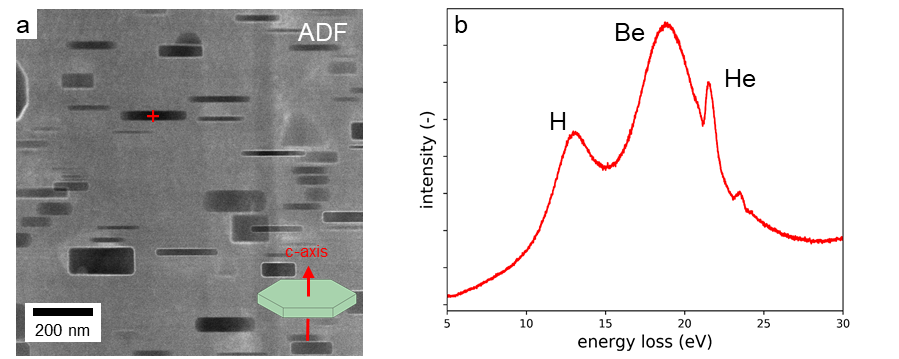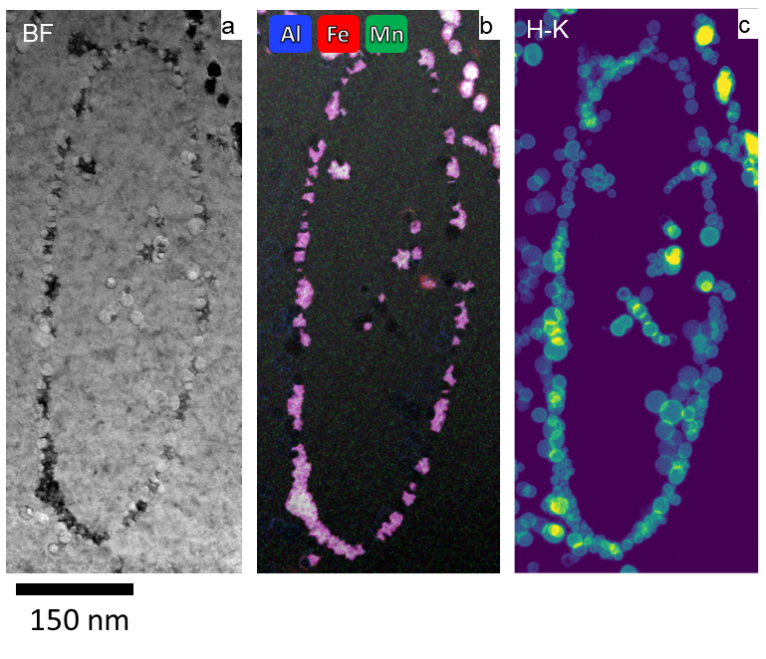Investigation of a high-dose irradiated beryllium microstructure including a STEM-EELS analysis of helium/tritium-bubbles
- Abstract number
- 282
- Event
- European Microscopy Congress 2020
- DOI
- 10.22443/rms.emc2020.282
- Corresponding Email
- [email protected]
- Session
- PSA.2 - Metals & Alloys
- Authors
- Nikolai Zimber (3), Pavel Vladimirov (3), Michael Dürrschnabel (3), Michael Klimenkov (3), Judith Lammer (2), Slava Kuksenko (1), Geralde Kothleitner (1)
- Affiliations
-
1. Culham Centre for Fusion Energy
2. Institute of Electron Microscopy and Nanoanalysis
3. Karlsruhe Institute of Technology
- Keywords
beryllium, bubble, EELS, hydrogen, helium, tritium trapping
- Abstract text
Beryllium is considered as a plasma facing material as well as an effective neutron multiplier for future nuclear fusion reactors [1]. Large amounts of helium and tritium will be generated by neutron-induced transmutation in beryllium during operation. Accumulation of the radioactive gas tritium (t1/2= 12.3 y) within 300 tons of beryllium pebbles required for the demonstration fusion reactor DEMO could imply severe safety and waste processing issues. In order to assess the tritium inventory, a fundamental understating of the microstructure developing during neutron irradiation is necessary.
In this work we present detailed analytical transmission electron microscopy (TEM) studies of the microstructural changes in beryllium after the high-dose irradiation program (HIDOBE-02). The beryllium samples we investigated were irradiated with neutrons during the four year-long irradiation campaign up to a displacement damage of 34 dpa, a helium concentration of 5500 appm and a tritium content of 600 appm at 387 °C, 480 °C and 600 °C. We prepared thin lamellae using an FEI Helios Dual Beam focused ion beam (FIB) microscope. For the energy dispersive x-ray (EDX) measurements, we used an FEI TALOS equipped with an X-FEG and a Super-X detector. Furthermore, we performed Electron Energy Loss Spectroscopy (EELS) measurements with an aberration-corrected FEI Titan equipped with an X-FEG, an electron monochromator and a Dual EELS-Gatan Imaging Filter (GIF) Quantum.
Figure 1: (a) Annular Dark Field (ADF) image of the irradiated Be microstructure. The green 3-D model illustrates the hexagonal prismatic disc shape of the bubbles. (b) Low-loss region of an EEL spectrum acquired within a closed gas bubble as marked by the red cross. Beside the Be-plasmon at ~19.0 eV, the H-K edge at ~12.7 eV and the He-K edge at ~21.4 eV are also visible.
For the first time, we confirmed the co-existence of helium and tritium inside gas bubbles located in the grain interior (see Figure 1 (b)) as well as at grain boundaries using EELS. In addition, we have shown that in hexagonal bubbles (see Figure 1 (a)) tritium predominantly occupies the basal planes. As a second step, we performed simultaneous EDX and EELS measurements (see Figure 2). We could also see a strong tritium trapping (Figure 2 (c)) in nano-scaled bubbles that are attached to precipitates (Figure 2 (b)) that formed at dislocation lines or freely in the matrix. Finally we used the results to quantify the amount of tritium within bubbles, i.e. to determine the He/H3-ratio, which is crucial in order to understand the beryllium-tritium interaction mechanisms.
Figure 2: (a) Bright field image (BF) of a dislocation loop decorated with precipitates and bubbles; (b) EDX map showing Al, Fe and Mn precipitates, (c) H-K edge EELS intensity map
Our observations confirm the assumption that tritium is trapped directly inside the He-bubbles located within single grains and at their grain boundaries, even at irradiation temperatures of ³ 600 °C [2]. Our results further suggest that tritium is not completely in a gaseous state inside the bubbles but the majority is rather bound in the form of a hydride as we could measure the H-K edge also in bubbles that had been cut open during FIB preparation. This hypothesis is supported by our recent density functional theory (DFT) calculations which predict a strong hydrogen adsorption at the (0001) Be surfaces due to the formation of BeH2.
- References
1] F. Hernández, P. Pereslavtsev, Q. Kang, P. Norajitra, B. Kiss, G. Nádasi, O. Bitz, A new HCPB breeding blanket for the EU DEMO: Evolution, rationale and preliminary performances, Fusion Engineering and Design 124 (2017) 882–886.
[2] V. Chakin, R. Rolli, P. Vladimirov, A. Möslang, Tritium and helium release from beryllium pebbles neutron-irradiated up to 230 appm tritium and 3000 appm helium, Nuclear Materials and Energy 9 (2016) 207–215.


